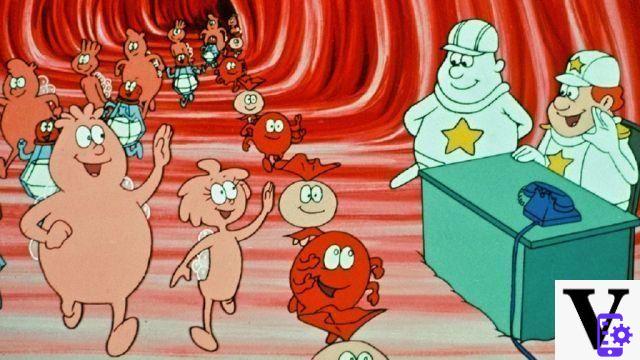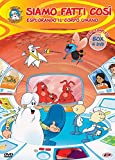For this time we make an exception: we will not talk about an anime but of a Franco-Belgian school cartoon that everyone, absolutely everyone, saw when we were little and that is part of our collective imagination. Following the great success of the film Hallucinating Journey of 1966, based on the famous novel by Isaac Asimov, the challenge was marked: to understand what happens inside our body.
We are at the end of the 80s when in Italy it airs for the first time "That's how we are done". It is a different animated TV series to those broadcast in those years. There is no mention of a tormented love story, of adventures and fights or of sporting challenges. “We are like this” is in fact the title of an educational television series that does not come from Japan, but from France. "Once upon a time the life"Is in fact the original title of this cartoon which, through nice characters, tries to teach the little ones science and, above all, the functioning of the human body.
We are like this: what is it about?
The animated series, consisting of 26 episodes, kicks off from the beginning of everything and asks itself a question: how did life on earth come about? From the birth of the solar system, about 6 million years ago, to the formation of our planet, the first episode of "We are made like this" tells the formation of the earth leading to the creation of the cell, "the smallest form of independent life" from where life started. Through animated characters - divided into good and bad according to their function in the human body - the formation of the cell is therefore told, then its evolution up to birth of the human body. But the story of 'We are like this' does not end there.
Episode after episode, the animated TV series explains the functioning of the various organs of our body: this is how two cute little animals interpret photons and electrons, explaining the functioning of the eyes; or well-informed scientists monitor digestion in what appears to be a studio complete with a monitor inside the stomach. But in the course of the cartoon viewers are also explained how the liver, kidneys and even the lymphatic system work, all through humanoid-looking protagonists who perform their function within the human body. The tale also makes use of real human characters, children, men or women, who play the part of the sick. The episode then goes on to explore the body of the protagonist in question, explaining what is happening in his organism.
 The end
The end
In the course of the scientific story, suitable for children but also for adults, we also talk about the skeleton, viruses and bacteria. But also of muscles, of the mouth and teeth, of the brain and of the blood. But we also get to talk about age, dreams and how they affect human life. After the episode that tells the functioning of the heart, "We are made like this" ends with the appointment dedicated to breathing, perhaps one of the most famous of the entire series. The friends red blood cells (Emo, Globina, and the elderly Globus) are busy carrying on their backs, in a long and tiring journey, some 'bubbles' that represent oxygen. All this is not without obstacles, represented by smoke and dust.
That's how we are: the success of the educational series
We Are Like This (or Exploring the Human Body for DeAgostini), as mentioned is a French animated series created by Albert Barillé. If anyone today might find it 'boring', as it was born with an educational purpose, the reality is that the children of the 80s and 90s loved it. It is no exaggeration to say that, thanks to this series, many children of that time decided to study as great medicine. The Barillé show is, to date, remembered as a great success of those years and not only because it managed to entertain its spectators, but also because it was able to keep them glued to the screen not with fights, competitions and loves, but with teachings. scientific.
Curiosity
There is no shortage of anecdotes and curiosities about the series 'We are made like this'.
 The episodes
The episodes
One of the details that immediately jump to the eye when comparing the French TV series and its Italian broadcast is the order of the episodes. Indeed, it is curious to discover that it is not the same. If the 'Italian' edition ends with the episode dedicated to breathing, the French one ends with the one dedicated to “The ages of man”. But it is not only the ending that differs: the order of the episodes is quite different. If the French one has an order that we could consequential and logical, the Italian one is essentially scattered, without a particular meaning.
The representation of the characters
It is certainly the representation of the elements that make up and characterize the human body that is the most brilliant part of the show and the promoter of its success. Albert Barillé has in fact managed to find the perfect key to tell the little ones about the functioning of the human body. Any process towards healing from a disorder then becomes a battle between the good and the bad. So we find ourselves witnessing the clash between the army of White Blood Cells, represented as policemen, against viruses and bacteria drawn as real villains; or, if only the White Blood Cells did not make it, the intervention of antibodies interpreted by characters equal to humans who move in small spaceships. The red blood cells are then humanoid with a large bag placed on the back that serves to carry oxygen, the mineral salts are represented as salt cellars and so on.
 Exploring the human body
Exploring the human body
If We are made like this is the title chosen for the broadcast of the cartoon on Mediaset, it must be remembered that the animated series was also spread by DeAgostini albeit with another title: Exploring the human body. The success of the product is certainly also attributable to this series of issues periodically released on newsstands, through which the human body, its functioning and many curiosities were explained. In addition to the files, DeAgostini then made 13 VHS available (distributed every 2 weeks) which later became 26 DVDs based on the Italian version of the original show. Finally, the series released on newsstands was then accompanied by pieces of an anatomical model of a human body.
In 2019 the animated series, complete and restored in HD, was added to the Netflix streaming platform.
The abbreviation
The Italian theme song is the famous 'We are made like this', sung by Cristina D'Avena with music by Massimiliano Pani and text by Alessandra Valeri Manera.
You are eager for a little more 80s nostalgia? We recently ventured into the adventures of the three thieves featured in Cat eyes, in the troubled history of Lady Oscar, between Sorgenti Maledette with Ranma 1 / 2, among the thousand messes of Doraemon e Nobita, among the sporting challenges of Holly and Benji e Mila and Shiro. But also a lot, more!
 We Are Made This Way - Exploring The Human Body (Box 4 Dvd)
We Are Made This Way - Exploring The Human Body (Box 4 Dvd)
- Kids Animation (Actor)




















![[Review] Samsung Powerbot VR7000: the robot vacuum cleaner from Star Wars](/images/posts/6bc44de38605b5c0fa12661febb1f8af-0.jpg)





